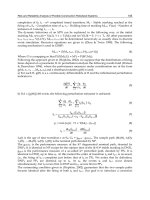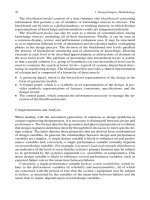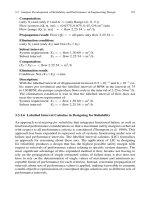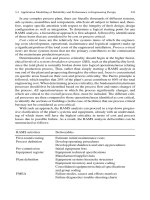Electromotive Force and Measurement in Several Systems Part 6 ppsx
Bạn đang xem bản rút gọn của tài liệu. Xem và tải ngay bản đầy đủ của tài liệu tại đây (500.07 KB, 15 trang )
Electromotive Force and Measurement in Several Systems
64
b. with binary system with the limited solubility based on more noble initial component;
c.
with the binary system, characterized by presence of limited solid solutions based on
more noble component and intermediate phase of variable compositions;
Application of the (19) equation to fig. 2 formally differs from binary systems that at
х=0,
1
*
0
yy
BC
Z
. At calculations value of last function can be borrowed from the literature.
In works of [M.Babanly et.al, 1992] in detail considers calculation procedures ITF for each
types of phase given in fig.2
3. Solid-state superion conductors with Ag
+
and Cu
+
conductivity
Solid electrolytes - materials possessing high ionic conductivity in a solid state, - are object
of comprehensive investigation in various areas of physics and chemistry. From the end of
60
th
years of the last century interest to this unique class of compounds invariably extended.
Solid superionic conductors are the major functional materials of a modern materials science
and technology. They are used with the big success as electrochemical sensor controls,
electrodes or electrolytes materials in devices of electrochemical transformation energy - in
solid-state batteries, displays, high-temperature fuel elements, etc. [Gurevich & Kharkats,
1992; Hagenmuller & Gool,1978; Ivanov-Shits & Murin 2000; West, 1981]. Discovery of solid
electrolytes with pure ionic conductivity also has given a new impulse to thermodynamic
investigations by electromotive forces method (EMF) and has allowed to extending
considerably number of systems studied by this method [M.Babanly et.al, 1992].
Classical example for solid cationconducting electrolytes is high-temperature modification
silver iodide -AgI, existing at temperature above 146°С. High electroconductivity (~1 Om
-1
·
sm
-1
) the given phase which on 4 order exceeds that for low-temperature modification -AgI
have found out in 1914 year by Tubandt and Lorentz. In the range of temperatures from 146
to melting temperature 555°С ionic conductivity of -AgI monotonously increases, and even
in a melting point a little bit decreases [West, 1981].
Silver iodide has appeared good basic compound for synthesis new solid electrolytes
possessing high ionic (Ag
+
) conductivity at room and lower temperatures. It is usually
reached by addition to it of the ions which stabilizing cubic structure and interfering its
transformation at low temperatures in hexagonal, close-packed on anions. So unipolar solid
electrolytes with high ionic conductivity have been synthesized at a room temperature:
Ag
8
SI, Ag
8
SBr, a solid solution 0,78AgI·0,22Ag
2
SO
4
, Ag
7
I
4
PO
4
, Ag
19
I
15
P
2
O
7
, Ag
6
I
4
WO
4
, and
also the gained greatest distribution group of compounds with general formula Ag
4
MI
5
,
where M=Rb, K, NH
4
, Cs
1/2
, K
1/2
. Electrolytes with general formula Ag
4
MI
5
have one of the
highest values of ionic conductivity at a room temperature (~0.2Om
-1
·sm
-1
) among which it
is necessary to allocate so-called "rubidic" electrolyte Ag
4
RbI
5
electroconductivity which is
long time was record-breaking high (0,25 Om
-1
·sm
-1
). This compound has superionic
conductivity at extremely low temperature - 151°С which there is a phase transition
[Ivanov-Shits & Murin, 2000; West, 1981]. At 64°C Ag
4
RbI
5
undergoes second sort phase
transition, however for this reason electroconductivity changes continuously.
The Ag
4
RbI
5
melts at 503K with decompose on peritectic reaction, and below 300 K it
decomposes on solid state reaction [Ivanov-Shits & Murin, 2000]. However, last process
kinetically is strongly broken and at observance of certain care (absence of a moisture and
iodine vapor) Ag
4
RbI
5
can be cooled easily without decomposition below a room
temperature and to use as solid electrolyte.
The EMF Method with Solid-State Electrolyte
in the Thermodynamic Investigation of Ternary Copper and Silver Chalcogenides
65
In the beginning of 70th years of lost century have been synthesized the Cu
+
conducting
superionic conductors which mainly halides of copper. In 1979 the Japanese and indepen-
dently American chemists have been synthesized related "rubidic" electrolyte the solid elect-
rolyte Cu
4
RbCl
3
I
2
possessing at a room temperature record-breaking high (0,5 Om
-1
·sm
-1
)
ionic conductivity on Cu
+
cations [Gurevich & Kharkats 1992; Ivanov-Shits & Murin, 2000].
The discovery of solid-state electrolytes with pure Cu
+
and Ag
+
conductivity was stimulate
to thermodynamic investigation of systems based on copper and silver by EMF method.
The electrochemical cell in the EMF method with solid cationconducting electrolyte like:
(-) А (solid or liquid) | ionic conductor on A
z+
| А in alloy (solid or liquid) (+) (20)
Where the left electrode has pure A component, and right - a homogeneous or
heterogeneous alloy of multicomponent system.
As solid electrolytes, basically, superionic conductors with pure ionic conductivity are used,
as only in this case there is unique dependence between EMF value (E) and Gibbs energy of
potentialforming reactions, in condition of constants charge of the ion causing
electroconductivity. Presence of electronic making conductivity leads to decrease of EMF
value of cells in comparison with its thermodynamic value as active electrons cause short
circuit electrolytic chains through internal resistance of electrolyte. As a result of it in cells
with the mixed conductors is not reached the equilibrium condition [M.Babanly et.al, 1992].
The solid electrolytes divides two electrode spaces and the last can contain solid phases,
liquids or gaseous substances of the identical or various chemical natures. For example, on
both side of solid electrolyte there can be gaseous oxygen at two kinds of various partial
pressures.
For the first time the electrochemical cell of type (20) has been used for thermodynamic
research of two-component system of Ag-S, where as solid electrolyte served -AgI [West,
1981]. For this purpose it was measured of EMF of concentration chain
(-) Ag (solid) | -AgI (solid) | Ag
2
S (solid)+S (liquid), graphite (+)
at the 450-550 К temperature range.
Considering, that in system Ag-S is formed only one binary compound Ag
2
S with narrow
homogeneity area, and solubility of Ag
2
S in liquid sulphur in the specified temperatures
range is insignificant, potentialforming reaction can be given as:
Ag (solid)+0,5 S (liquid)=0,5 Ag
2
S (solid)
From experiments have received temperature dependence of EMF and authors have
calculated,
G°,
H° and
S° of Ag
2
S
4. Thermodynamic investigation of the ternary chalcogenides based on
copper and silver by EMF method with solid-state electrolytes
Chalcogenides of copper and silver with р
1
-р
3
elements [Max Plank Institute, 1992-1995;
M.Babanly et.al, 1993; Shevelkov, 2008] have the practical interest as functional materials
of electronic techniques (photoelectric, thermoelectric and magnetic semiconductors,
superconductors, superionic conductors etc.).
Phase equilibriums in the specified systems are studied in the many works which are results
are periodically systematized and critically analyzed in a number of handbooks and
monographies [Max Plank Institute, Stuttgart, 1992-1995; M.Babanly et.al, 1993].
Electromotive Force and Measurement in Several Systems
66
For investigation solid-phase equilibria in the systems A-B-X (A-Cu, Ag; B-elements of
subgroups of gallium, germanium, arsenic; X-S, Se, Te) and thermodynamic properties of
ternary compounds formed in them we had been made concentration chains of types:
(-) Cu (solid) | Cu
4
RbCl
3
I
2
(solid) | (Cu in alloy) (solid) (+) (21)
(-) Ag (solid) | Ag
4
RbI
5
(solid) | (Ag in alloy) (solid) (+) (22)
The equilibrium alloys from various phase areas of the above-mentioned systems served as
the right electrodes.
The compound Cu
4
RbCl
3
I
2
synthesized by melting stochiometric amounts of chemically
pure, anhydrous CuCl, CuI and RbCl in evacuated (10
-2
Pa) quartz ampoule at 900 K with
the cooling to 450K and annealed at this temperature for 100 h. Ag
4
RbI
5
synthesized from
chemically pure RbI and AgI by a technique [West, 1981]: stochiometric mix initial iodides
have co-melted in evacuated quartz ampoule (~10
-2
Pa) and then quickly cooled to a room
temperature. At cooling melt crystallizes in fine-grained and microscopic homogeneous
state and then annealed at 400K for 200 h. Obtained cylindrical ingots in diameter ~8mm
cuts like pellets in the thickness of 4-6 mm which used as solid electrolyte in chains of types
(21) and (22).
The elementary copper and silver served as left electrodes and the right electrodes pre-
synthesized and annealed alloys of investigated systems from various phase areas.
Compositions of alloys have been chosen from data on phase equilibrium. For preparation of
the right electrodes annealed alloys grinded as powder, and then pressed as pellet in weight of
0,5-1 gram. The electrochemical cell of type in fig. 3 has filled with argon and has placed in the
tube furnace, where it held at ~380К for 40-50 hours. Cell temperature measured by chromel-
alumel thermocouples and mercury thermometers with accuracy0,5
0
С.
Fig. 3. The electrochemical cell for EMF measurement of chains of type (4.1) and (4.2). 1-
glass block; 2-cover; 3-platinium wires; 4-platinium plates; 5-copper (silver) plate; 6-solid
electrolytes; 7-investigated alloy (the right electrode); 8-thermocouple, 9-clip [M.Babanly,
et.al. 2009].
The EMF Method with Solid-State Electrolyte
in the Thermodynamic Investigation of Ternary Copper and Silver Chalcogenides
67
EMF measured by the compensation method by means of high-resistance digital voltmeters
В7-34А. Measurements were carried out in each 3 hours after an establishment of certain
temperature. Equilibrium considered those values of EMF which at repeatedly
measurement at the given temperature differed from each other not more than on 0,5 mV
irrespective from direction of temperature change. In order to of occurrence elimination
thermo-e.m.f. contacts of all leads with copper wires had identical temperature.
EMF measurements of alloys of selenium and tellurium containing systems are carried out
in the range temperatures of 300÷420K, and sulphur containing 300÷380 K. Maximum limits
of temperature intervals of EMF measurements are chosen to exclude melting and
transition in a metastable state of alloys of the right electrodes.
Processing of the EMF measurements results. For the thermodynamic calculations the
results of the experiments were used, which are satisfying to criteria of the reversible work
of a chain. Results of EMF measurements for alloys with different compositions within one
heterogeneous area were processed in common.
Measured equilibrium values of EMF put on E=f (T) diagram. Appreciable deviations from
linear dependence of EMF were not observed. It is indirectly confirms a constancy of
compositions of existing phases in heterogeneous areas of the investigated systems, that, as
shown above, is a necessary condition for carrying out of thermodynamic calculations
according to the EMF measurements of chains of type (21) and (22). Considering this, results
of EMF measurements processed by the least squares method [Gordon, 1976]. Temperature
dependence is expressed by the linear equation
Ea TE ( )bbTT
. (23)
Here
i
E
E
n
,
i
T
T
n
,
ii
2
ii
(E -E)(T T)
E(T T)
b
, where, Е
i
–experimental values of EMF at
temperature Т
i
; n – number of experimental points (both values Е and Т), aEbT .
The statistical estimation of error of measurements consisted in calculation of dispersions of
individual measurements of EMF
()
E
, average EMF values (
2
E
), and also coefficients a
(
2
a
) and b (
2
b
) on relations
2
22
b
(T) (T T)
E
E
n
2
ii
2
(E E )
2
E
n
2
22
2
E
a
2
i
(T)
(T T)
E
T
n
2
2
E
B
2
i
(T)
(T T)
i
E
- EMF values, calculated by (23) equation at temperature Т
i
. Errors (
i
) corresponding
values calculated by the relations
Electromotive Force and Measurement in Several Systems
68
ii
t
(t–Student’s test,
i
–standard deflection). In the present work n20, that at confidential level
of 95 % leads to t2 [Gordon, 1976].
The accepted equations of temperature dependences of EMF according to the
recommendation of [Kornilov et.al, 1972] are presented as:
1
22 2
2
EE
2
i
(T T)
2
n
(T T)
EabT
(24)
From the accepted equations of type on relations (13) - (15) calculated relative partial molar
free Gibbs energy, enthalpy and entropy of copper (silver) in alloys at 298K.
The Cu-Tl-Te system is studied by EMF measurement of concentration chains of type (21)
in the Tl
2
Te-Cu
2
Te-Te composition field and with taking into account literature data [Max
Plank Institute, Stuttgart, 1992-1995; M.Babanly, 1993] the fragment of the solid phase
equilibrium diagram (fig. 4) is constructed.
Fig. 4. The solid phase equilibrium diagram of the Cu-Tl-Те system. In some solid phase
fields are given the EMF values (mV) of chains of type (5.1) at 300K.
In fig.4 we can see, that in the specified compositions fields five ternary compounds are
formed. Compound CuTl
4
Te
3
forms continuous solid solutions () with Tl
5
Te
3
. Areas of
homogeneity of other ternary and binary compounds of the system are insignificant.
The EMF measurements of chains of type (21) have shown that values of electromotive
forces in each three-phase areas on fig. 4 are constant irrespective of total composition of
alloys and in discontinuous change on their borders, and in two-phase area TlTe+ and
within homogeneity area -phases continuously change depending on composition of last.
Reproducibility of EMF measurements and conformity of sequence of their change in
investigated system the thermodynamic conditions (impossibility of reducing of EMF values
The EMF Method with Solid-State Electrolyte
in the Thermodynamic Investigation of Ternary Copper and Silver Chalcogenides
69
in direction CuTl
x
Te
1-x
) to specify possibility of use of these data for thermodynamic
calculations.
For calculation of thermodynamic functions of ternary compounds and -phases of variable
composition have been used data of measurements in phase areas №№ I-V on fig. 4
(table 1).
№ Phase area
,()
E
EmV a bT t S T
1 TlTe+δ(Cu
0,2
Tl
4,8
Te
3
)
1/2
52
0,7
317, 4 0,138 2 3,8 10 ( 351,2)
26
TT
2 TlTe+ δ(Cu
0,4
Tl
4,6
Te
3
)
1/2
52
0,6
296,8 0,086 2 3,6 10 ( 351,2)
26
TT
3 TlTe+ δ(Cu
0,6
Tl
4,4
Te
3
)
1/2
52
1,3
290,1 0,032 2 9,8 10 ( 351, 2)
26
TT
4 TlTe+ δ(Cu
0,8
Tl
4,2
Te
3
)
1/2
42
1,8
279, 3 0,009 2 1,2 10 ( 351,2)
26
TT
5 δ (CuTl
4
Te
3
)
1/2
42
1,5
281,7 0,047 2 1,1 10 ( 351,2)
26
TT
6 Tl
2
Te
3
+CuTlTe
2
+Te
1/2
42
3,2
286, 3 0,073 2 1,5 10 ( 353,7)
24
TT
7 CuTlTe
2
+Cu
2
TlTe
2
1/2
42
2,1
224, 3 0,085 2 1,2 10 ( 353,7)
24
TT
8 Cu
2
TlTe
2
+ Cu
3
TlTe
2
1/2
52
1,9
216, 5 0,066 2 8,9 10 ( 353,7)
24
TT
9 Cu
3
TlTe
2
+Cu
9
TlTe
5
+Cu
4
Te
3
1/2
42
2,6
200, 4 0,091 2 1,4 10 ( 353,7)
24
TT
Table 1. The temperature dependences of EMF of concentration chains of type (21) in some
phase areas of the Cu-Tl-Те system (Т=300420К).
From the accepted equations of temperature dependences of EMF (tab. 1) the relative partial
thermodynamic functions of copper in alloys at 298K (tab. 2) are calculated.
Isotherms of partial thermodynamic functions of copper on the section Tl
5
Te
3
-CuTl
4
Te
3
(fig.
5) have continuous curves that specifies in formation of a continuous number of solid
solutions between these compounds.
Electromotive Force and Measurement in Several Systems
70
Phase area
Cu
G
Cu
H
Cu
S ,
JК
-1
mole
-1
kJmole
-1
Tl
2
Te
3
+CuTlTe
2
+Te
29,7230,142 27,62084 7,042,36
CuTlTe
2
+Cu
2
TlTe
2
24,0860,123 21,640,74 8,202,11
Cu
2
TlTe
2
+ Cu
3
TlTe
2
22,7870,104 20,890,65 6,371,82
Cu
3
TlTe
2
+Cu
9
TlTe
5
+Cu
4
Te
3
21,953,0,136
19,340,82 8,782,28
TlTe+(Cu
0,2
Tl
4,8
Te
3
) 34,5930,071 30,590,42 13,321,19
TlTe+(Cu
0,4
Tl
4,6
Te
3
) 31,1100,070 28,640,41 8,301,16
TlTe+(Cu
0,6
Tl
4,4
Te
3
) 28,9110,110 27,990,67 3,091,91
TlTe+(Cu
0,8
Tl
4,2
Te
3
) 27,2080,123 26,950,74 0,862,11
(CuTl
4
Te
3
) 25,8290,117 27,180,69 -4,532,02
Table 2. The relative partial thermodynamic functions of copper in Cu-Tl-Те alloys at 298 К.
Fig. 5. Dependences of partial thermodynamic functions of copper with compositions on the
Tl
5
Te
3
-CuTl
4
Te
3
section at 298К.
According to fig. 5, increasing of concentration of copper in solid solutions is accompanied
by considerable decreasing of composition-sensitive function of
Cu
S that good agree with
structural data of CuTl
4
Te
3
and -phases [M.Babanly et.al, 1993].
The standard thermodynamic function of formation of -phase and ternary compound
CuTl
4
Te
3
are calculated by graphical integration of Gibbs-Duhem equation on the beam
section of Cu-[Tl
4
Te
3
]
(where, [Tl
4
Te
3
]-two-phase mix Tl
5
Te
3
и TlTe).
Insignificance of homogeneity areas of ternary compounds CuTlTe
2
, Cu
2
TlTe
2
, Cu
3
TlTe
2
and
Cu
9
TlTe
5
and co-existing phases with them (Tl
5
Te
3
, Cu
4
Te
3
and Te) in three-phase areas №№
II-V (fig. 4) allows calculate their standard thermodynamic functions of formation and
standard entropy by method potentialforming reactions. According to fig. 4, the partial
molar functions of copper in the specified phase areas are thermodynamic characteristics of
following potentialforming reactions (all compounds in crystalline state):
The EMF Method with Solid-State Electrolyte
in the Thermodynamic Investigation of Ternary Copper and Silver Chalcogenides
71
Cu+0,5Tl
2
Te
3+0
,5Te=CuTlTe
2
(4.5)
Cu+CuTlTe
2
=Cu
2
TlTe
2
(4.6)
Cu+Cu
2
TlTe
2
=Cu
3
TlTe
2
(4.7)
Cu+0,5Cu
3
TlTe
2
+0,5Cu
4
Te
3
=0,5Cu
9
TlTe
5
(4.8)
Based on these reactions the thermodynamic functions of formation and standard entropy of
corresponding ternary phases have been calculated.
At calculations besides experimental data (tab. 2) the corresponding thermodynamic data
for compounds Tl
2
Te
3
, TlTe, Tl
5
Te
3
[M.Babanly et.al, 1993.] and Cu
4
Te
3
[Abbasov, 1981], also
standard entropy of copper and tellurium [Yungman, 2006] were used. Errors calculated a
method of accumulation of errors.
The obtained values of standard thermodynamic functions of formation and standard
entropy of ternary compounds Cu
2
TlTe
2
, Cu
3
TlTe
2
and Cu
9
TlTe
5
are well agree with the
results [M.Babanly et.al, 2011] which is obtained from EMF measurements of concentration
chains concerning a thallium electrode with liquid electrolit (tab. 3).
Compound
0
(298 )
f
GK
0
(298 )
f
HK
0
(298 )SK
,
JК
-1
mole
-1
kJmole
-1
Tl
5
Te
3
[31]
213,61,7 216,72,0 458,66,7
(Cu
0,2
Tl
4,8
Te
3
) 210,21,7 213,02,2 4547
(Cu
0,4
Tl
4,6
Te
3
) 207,81,6 210,52,3 4497
(Cu
0,6
Tl
4,4
Te
3
) 205,31,6 207,62,4 4448
(Cu
0,8
Tl
4,2
Te
3
) 203,81,5 206,02,5 4388
CuTl
4
Te
3
201,41,4 203,82,6 4339
Table 3. The standard integral thermodynamic functions of solid solutions Cu
х
Tl
5-х
Te
3
(0<х<1).
From EMF measurements of concentration chains of types (21) and (22) the standard
thermodynamic functions of formation and standard entropy of some ternary chalcogenides
of copper (tab. 4) and silver (tab. 5) are calculated. Herein, some data are published for the
first time, which are the sources do not show. In the tab.4 and 5 also presence the
thermodynamic functions of thallium containing ternary compounds of copper and the
silver which are obtained by EMF method with liquid electrolyte (Italic font). The data
presented in tables strongly differ on errors. It is due to with different errors of
thermodynamic functions of the binary compounds which are recommended in the
handbooks [M.Babanly et.al, 1992; Кubaschewski, 1993; Mills, 1974, Yungman, 2006] which
have been used at calculations.
Electromotive Force and Measurement in Several Systems
72
Compound
0
(298)
f
G
0
(298)
f
H
0
(298)S
References
kJ/mole
JК
-1
mole
-1
CuIn
3
Se
5
380,0±1,4 398,2±28,6 373±28 [Babanly, N.B., 2009]
CuInSe
2
153,2±0,6 158,0±9,6 163±11 [Babanly, N.B., 2009]
CuTlS
2
94,30,7
91,5
0,5
93,61,4
98,6
4,0
172,72,8
[Babanly, N.B., 2009]
[Babanly, M.B., 1986]
CuTlS
90,30,7
84,1
1,5
88,32,1
82,1
4,9
132,46,2
[Babanly, N.B., 2009]
[Babanly, M.B., 1986]
Cu
3
TlS
2
163,82,6
152,7
1,8
159,29,8
145,8
12,3
251,85,8
[Babanly, N.B., 2009]
[Babanly, M.B., 1986]
Cu
9
TlS
5
373,83,9
354,6
4,5
371,821,4
339,7
30,8
529,019,0
[Babanly, N.B., 2009]
[Babanly, M.B., 1986]
CuTlSe
2
96,290,16
96,5
0,6
97,910,95
97,2
1,3
176,15,1
[Babanly, M.B., 1992]
CuTlSe
84,490,16
84,2
1,3
81,370,85
80,5
3,9
149,92,8
[Babanly, M.B., 1992]
Cu
2
TlSe
2
119,060,27 118,611,54 216,26,8
CuTlTe
2
75,10,4 72,61,3 2084
Cu
2
TlTe
2
99,20,5
94,8
0,9
94,32,1
92
7
2496
237
3
[Babanly, M.B., 2010]
Cu
3
TlTe
2
122,00,6
117,1
1,2
115,22,7
117
5
2888
263
4
[Babanly, M.B., 2010]
Cu
9
TlTe
5
264,32,6
244,0
2,4
253,89,8
2431
14
63715
621
7
[Babanly, M.B., 2010]
CuTl
4
Te
3
201,41,4 203,82,6 4339
Cu
2
GeS
3
22512 22613 1898
[Babanly, M.B. 2001]
Cu
8
GeS
6
45613 42918 57924
[Babanly, M.B. 2001]
Cu
2
GeS
6
18211 18211
35 [Babanly, M.B. 2001]
CuGe
3
Se
4
25256 24655 314,58,4
[Babanly, M.B. 2001]
CuGeSe
2
13121 12921 154,97,0
[Babanly, M.B. 2001]
Cu
2
GeSe
3
178,418,8 174,519,7 223,46,6
[Babanly, M.B. 2001]
Cu
2
GeTe
3
89,613 9214 23612
[Babanly, M.B. 2001]
Cu
2
Sn
4
S
9
659,94,3 650,929,7 560,374,7
[Babanly, M.B. 2001]
Cu
2
SnS
3
239,61,5 242,612,0 196,321,9
[Babanly, M.B. 2001]
Cu
4
SnS
4
316,42,4 327,718,8 266,528,2
[Babanly, M.B. 2001]
Cu
2
SnSe
3
205,52,2 207,614 24427,9
[Babanly, M.B. 2001]
Cu
2
SnTe
3
124,31,9 118,711,6 27815,9
[Babanly, M.B. 2001]
Cu
3
AsS
4
179,2±0,6 172,2±2,6 278±8
Cu
6
As
4
S
9
429,4±1,2 419,5±8,2 673±23
Cu
4
As
2
S
5
257,8±0,8 249,8±4,6 395±13
Cu
3
AsS
3
170,2±0,6 163,9±2,7 254±8
CuAsS 69,5±0,3 64,1±1,7 109±5
Cu
2
As
4
Se
7
206,7±1,6 208,1±10,6 501±17
The EMF Method with Solid-State Electrolyte
in the Thermodynamic Investigation of Ternary Copper and Silver Chalcogenides
73
Compound
0
(298)
f
G
0
(298)
f
H
0
(298)S
References
kJ/mole
JК
-1
mole
-1
CuAsSe
2
74,6±0,5 73,8±3,2 156±6
Cu
3
AsSe
4
163,5±1,1 157,2±5,6 325±12
Cu
4
As
2
Se
5
233,6±2,4 227,9±8,8 472±21
Cu
3
AsSe
3
158,0±1,3 151,5±5,3 296±13
Cu
3
AsTe
3
91,2±3,3 90,6±5,3 286±6 [Babanly, M.B. 2001]
Cu
3
SbS
4
207,5±3,9 200±6,3 298±18 [Babanly, M.B. 2001]
CuSbS
2
121,4±3,4 119±3,5 148±6,4 [Babanly, M.B. 2001]
Cu
3
SbS
3
197,8±3,8 189,3±6,5 269,5±13,7 [Babanly, M.B. 2001]
Cu
3
SbSe
4
191,6±2,5 178,6±5,4 358±18 [Babanly, M.B. 2001]
CuSbSe
2
101,4±1,8 98,5±2,2 173±8 [Babanly, M.B. 2001]
Cu
3
SbSe
3
175,6±2,5 164,0±5,3 311±15 [Babanly, M.B. 2001]
CuBiS
2
138,6±4,0 138,2±2,9 156±12 [Babanly, M.B. 2001]
Cu
3
BiS
3
213,0±4,4 209,9±5,2 264±21 [Babanly, M.B. 2001]
CuBi
3
Se
5
248,7±1,9 248,6±5,8 421,9±7,8 [Babanly, M.B. 2001]
CuBiSe
2
107,6±0,8 105,9±2,51 189,8±2,4 [Babanly, M.B. 2010]
Cu
3
BiSe
3
162,5±1,2 155,9±5,7 315,0±8,5 [Babanly, M.B. 2010]
Cu
9
BiSe
6
324,8±3,5 313,1±18,6 659±28 [Babanly, M.B. 2010]
CuBiTe
2
64,2±1,0 61,3±1,0 200±7 [Babanly, N.B. 2007]
Table 4. Standard thermodynamic functions of formation and standard entropy of some
ternary chalcogenides of copper.
Compound
0
(298)
f
G
0
(298)
f
H
0
(298)S
References
kJ/mole
J
К
-1
mole
-1
A
g
GaS
2
302,1±1,7 302,8±4,3 145,1±9,6 [Ibra
g
imova G.I., 2006]
A
g
9
GaS
6
447,5±2,4 393,9±12,4 786,8±27,8 [Ibra
g
imova G.I., 2006]
A
g
2
Ga
20
S
31
5131±21 5169±62 1772±87 [Ibra
g
imova G.I., 2006]
A
g
GaSe
2
237,0±3,4 239,4±5,6 159,6±11,2 [Ibra
g
imova G.I., 2006]
A
g
9
GaSe
6
433,0±4,1 413,1±10.9 742,9±32,5 [Ibra
g
imova G.I., 2006]
A
g
GaTe
2
120,8±4,6 119,6±3,1 186,8±6,9 [Ibra
g
imova G.I., 2006]
A
g
9
GaTe
6
276,8±11,5 233,4±11,0 867,0±30,7 [Ibra
g
imova G.I., 2006]
A
g
2
GeS
3
206±2,1 198±2,2 239,1±8,8 [Babanl
y
, M.B., 1993]
A
g
4
GeS
4
254±2,1 235±2,4 393,2±14,1 [Babanl
y
, M.B., 1993]
A
g
8
GeS
6
345±2,2 310±2,6 680,4±23,1 [Babanl
y
, M.B., 1993]
A
g
2
GeSe
3
145±2,1 139±2,2 262,2±10,4 [Babanl
y
, M.B., 1993]
A
g
8
GeSe
6
288±2,3 255±2,8 734,6±30,4 [Babanl
y
, M.B., 1993]
A
g
8
GeTe
6
268,0±1,0 245,0±7,0 745,8±17,1 [Babanl
y
, M.B., 1993]
A
g
2
S
n
2
S
5
358,8±2,3 339,5±12,6 397,9±16,3 [Babanl
y
, M.B., 1993]
A
g
2
SnS
3
213,3±1,6 202,7±8,8 260,7±16,8 [Babanl
y
, M.B., 1993]
A
g
8
SnS
6
351,7±2,6 328,9±18,0 652,9±16,3 [Babanl
y
, M.B., 1993]
A
g
8
SnS
5
355±3,2 330±3,8 628,43±23,6 [Babanl
y
, M.B., 1993]
Electromotive Force and Measurement in Several Systems
74
Compound
0
(298)
f
G
0
(298)
f
H
0
(298)S
References
kJ/mole
J
К
-1
mole
-1
A
g
SnSe
2
146,4±0,5 148±3 162±7,2 [Babanl
y
, M.B., 1993]
A
g
8
SnSe
6
350,3±1,8 320,4±8,1 736,6±23,8 [Babanl
y
, M.B., 1993]
AgTlS
72,3±0,6
71,7±0,7
72,9±3,0
73,3±3,2
136,7±8,1
133,3±5,9
[Ibra
g
imova G.I., 2001]
[Babanly, M.B., 1993]
Ag
7
Tl
3
S
5
320,2±2,6
303,5±3,0
351,9±15,7
315,0±15,0
544,2±36,5
614,5±30,1
[Ibra
g
imova G.I., 2001]
[Babanly, M.B., 1993]
Ag
3
TlS
2
120,0±0,9
114,3±1,2
128,4±5,6
118,0±6,0
227,7±12,8
243,8±23,1
[Ibra
g
imova G.I., 2001]
[Babanly, M.B., 1993]
Ag
8
Tl
2
S
5
278,0±2,4
266,5±2,9
287,5±14,6
269,0±15,0
597,0±32,3
620,9±26,0
[Ibra
g
imova G.I., 2001]
[Babanly, M.B., 1993]
Ag
7
TlS
4
195,9±1,5
189,2±2,8
192,0±9,4
184,0±13,0
503,2±20,2
507,1±27,1
[Ibra
g
imova G.I., 2001]
[Babanly, M.B., 1993]
Ag
7
TlSe
4
227,1±0,4
234,8±1,9
183,4±1,9
198,3±6,7
676,7±15,1
652,9±27,9
[Babanly, M.B., 1982]
Ag
3
TlSe
2
130,8±0,2
133,3±0,9
113,5±1,1
116,8±3,2
333,9±12,8
292,2±14,1
[Babanly, M.B., 1982]
AgTlSe
80,4±0,2
82,4±0,5
74,3±1,2
75,8±1,8
173,9±5,9
176,9±7,7
[Babanly, M.B., 1982]
AgTlTe
2
69,7±0,7
69,9±0,7
71,5±1,8
62,1±2,3
199,9±5,7
232,1±7,2
[Babanly, M.B., 1982]
Ag
8
Tl
2
Te
5
273,4±2,0
267,9±3,3
253,3±6,8
234,4±6,9
784,1±21,6
829,7±19,7
[Babanly, M.B., 1982]
AgTlTe
67,3±0,5
69,3±0,6
63,6±1,2
62,8±2,0
168,8±5,9
178,7±6,0
[Babanly, M.B., 1982]
AgTl
3
Te
2
151,5±1,2
153,5±0,9
149,1±1,9
147,3±3,1
342,1±7,2
355,3±9,5
[Babanly, M.B., 1982]
Ag
9
TlTe
5
238,2±1,4
235,6±3,4
206,9±6,5
201,5±5,9
800,3±19,2
809,5±16,6
[Babanly, M.B., 1982]
AgAs
3
Se
5
111,9±10,5 112,5±0,5 359,1±7,5 [Babanly, M.B., 2009]
AgAsSe
2
55,6±3,6 54,4±3,5 167,0±3,8 [Babanly, M.B., 2009]
Ag
7
AsSe
6
214±4,2 199,5±6,5 637±16 [Babanly, M.B., 2009]
Ag
3
AsSe
3
107,8±3,8 101,8±4,6 310,7±7,7 [Babanly, M.B., 2009]
AgSbS
2
110±5 103±5 175,1±6,9 [Babanly, M.B., 1993]
Ag
3
SbS
3
153±5 141±7 309,2±13,3 [Babanly, M.B., 1993]
Ag
7
SbS
6
233±7 218±12 595,3±28,1 [Babanly, M.B., 1993]
AgSbSe
2
92,5±4,5 91,0±5 177,2±6 [Babanly, M.B., 1993]
AgSbTe
2
49,6±1,5 44,5±1,3 204,6±5 [Babanly, M.B., 1993]
AgBi
3
S
5
326,412,9 323,47,7 367,516,5
[Shykhyev Y.M. 1995]
AgBiS
2
124,24,4 118,63,0 166,36,8
[Shykhyev Y.M. 1995]
AgBiSe
2
100,50,8 94,12,3 20510
[Shykhyev Y.M. 2003]
Table 5. Standard thermodynamic functions of formation and standard entropy of some
ternary chalcogenides of silver.
The EMF Method with Solid-State Electrolyte
in the Thermodynamic Investigation of Ternary Copper and Silver Chalcogenides
75
5. Conclusion
The results of this chapter show that Cu
+
and Ag
+
conducting superionic conductors can be
successfully applied as solid-state electrolyte in the thermodynamic studies and
specification of solid-phase equilibria diagrams of ternary copper - and silver containing
systems by EMF method. Unlike from classical variant of EMF method with liquid
electrolyte they allow to investigate also the systems containing high electrochemical active
component than copper or silver (in our case, thallium). It is due to that the solid-state
electrolyte, unlike liquid, prevents percolation of collateral processes (interaction of
electrodes with electrolyte and through electrolyte among themselves) and by that allows to
obtain reproduced data for irreversible in classical understanding of concentration chains.
The specified advantage solid-state cation-containing systems by EMF methe of formation
and standard entropy of some ternary chalcogenides of silverrnary phases have been
conducting electrolytes allows to essentially expanding a circle of the systems investigated
by EMF method.
6. Acknowledgments
The authors would like to acknowledge to Dr. Samira Z. Imamaliyeva, Dr. Ziya S. Aliev
and Leyla F. Mashadiyeva and for carrying out experiments and preparation of this
chapter.
7. References
Abbasov, A.S. (1981). Thermodynamic Properties of Some Semiconductor Substances, Elm,
Baku
Babanly, M.B., Kuliyev A.A. (1982a). Phase Equilibria and Thermodynamic Properties of the
Ag-Tl-Se System. Russian Journal of Inorganic Chemistry,Vol.27, No.9 (September),
pp.1336-1340, ISSN 0036-0236
Babanly, M.B., Kuliev A.A. (1982b). Phase Equilibria and Thermodynamic Properties of the
Ag-Tl-Te System, Russian Journal of Inorganic Chemistry, Vol. 27, No.6 (June),
pp.867–872.
Babanly M.B., Kuliyev A.A. (1985a), Thermodynamic investigation and refined the phase
diagram o ternary chalcogenides systems by method EMF, In: Mathematical
Problems in Chemical Thermodynamics, Novosibirsk, Nauka, Siberian Section, pp.192-
201
Babanly M.B. (1985b), Application of partial heterogeneous molar functions method in
thermodynamic analysis of the ternary condensed systems, In: Application of
Mathematical Methods to studying Physico-Chemical Equilibriua, Vol.2, Novosibirsk
p.202-204
Babanly, M.B., Li Tai Un. & Kuliev, A.A. The Cu–Tl–S System (1986). Russian
Journal of Inorganic chemistry, Vol. 32, No.7 (July), p.1837-1844, ISSN 0036-
0236
Electromotive Force and Measurement in Several Systems
76
Babanly, M.B., Yusibov, Yu.A. & Abishov, V.T. (1992). Method of Electromotive Forces
in the Thermodynamics of Solid Semiconductor Substances, Baku State
University.
Babanly, M.B., Yusibov, Yu.A. & Abishev, V.T. (1993). Three-Component Chalcogenides on the
Basis of Copper and Silver, Baku, Baku State University.
Babanly, M.B., Babanly, N.B., & Mashadiyeva, L.F. (2001). Phase Diagrams and Thermodynamic
Properties of the Cu–B
IV
(B
V
)–Chalcogen Systems. Proceedings of VI International
School-Conference "Phase Diagrams in Material Science», pp.5-6, Kiev, October, 14-
20, 2001
Babanly, M.B., Shykhyev, Yu.M. &Yusibov Yu.A. (2003). Thermodynamic investigation of
ternary compounds of Ag-Tl-Te system by EMF method with solid-state
electrolyte. News of Baku University, natural science series, No.1, pp. 30-35, ISSN 1609-
0586
Babanly, M.B., Mashadiyeva, L.F., & Imamaliyeva, S.Z. (2009) Thermodynamic Study of the
Ag-As-Se and Ag-S-I Systems Using the EMF Method with a Solid Ag
4
RbI
5
Electrolyte. Russian Journal of Electrochemistry, Vol.45, No.4, (April 2009), pp.399–
404, ISSN 1023-1935,
Babanly, M.B., Salimov, Z.E., Babanly, N.B. & Imamalieva, S. Z. (2011). Thermodynamic
properties of copper thallium tellurides. Inorganic Materials, Vol. 47, No.4 (April),
pp.361-364, ISSN 0020-1685
Babanly, N.B., Mokhtasebzadeh, Z; Aliyev, I.I. & Babanly, M.B. (2007) Phase equilibriums in
the system Cu-Bi-Te and thermodynamic properties of CuBiTe
2
compound. Reports
of National Academi of Science of Azerbaijan, Vol.63, No.1, pp.41-54,
Babanly, N.B., Yusibov, Yu.A., Mirzoeva, R.J., Shykhyev, Yu.M. & Babanly, M.B. (2009).
Cu
4
RbCl
3
I
2
Solid Superionic Conductor in Thermodynamic Study of Three-
Component Copper Chalcogenides. Russian Journal of Electrochemistry, Vol. 45, No.4
(April), pp. 405–410, ISSN 1023-1935
Babanly, N.B., Aliev, Z.S., Yusibov, Yu.A.& Babanly, M.B. (2010). A Thermodynamic Study
of Cu–Tl–S System by EMF Method with Cu
4
RbCl
3
I
2
Solid Electrolyte.
Russian Journal of Electrochemistry, Vol.46, No.3 (March), pp.371-375, ISSN 1023-
1935
Babanly, N.B., Yusibov, Yu.A., Aliev, Z.S. & Babanly, M.B. (2010). Phase Equilibria in the
Cu–Bi–Se System and Thermodynamic Properties of Copper Selenobismuthites.
Russian Journal of Inorganic Chemistry, Vol.55, No.9 (September), pp.1471–1481, ISSN
0036-0236
Gordon, A; Ford, R. (1972). The chemists Companion. A handbook of practical data techniques and
references. A Wiley-Interscience Publication. New-York-London-Sydney-
Toronto
Gurevich, Yu.Ya; Kharkats, Yu.I. (1992). Superionic conductors, Nauka, ISBN 5-02-014622-6,
Moscow
Hagenmuller, P., Gool, W.V. (1978) Solid Electrolytes, General Principles, Characterization,
Materials, Applications, Acad. Press, ISBN 0-12-313360-2, New York, San Fransisco,
London
The EMF Method with Solid-State Electrolyte
in the Thermodynamic Investigation of Ternary Copper and Silver Chalcogenides
77
Ibragimova, G.I., Shikhiyev, Yu.M., & Babanly M.B. (2006). Solid Phase Equlibria in Ag-Ga-S
(Se,Te) systems and thermodynamic properties of ternary phases. Chemical
Problems, No.1, pp.23-28, ISBN 9952-8034-4-6
Ibragimova, G.I., Babanly, M.B., & Shykhyev Yu.M. (2001). Investigation of system Ag
2
Тe-
Ga
2
Тe
3
by EMF method. Proceedings of VII National Science conference "Physico-
chemical analyses and inorganic material science", pp.41-45, Baku State University,
Baku, May 21-23, 2001
Ibragimova, G.I., Shykhyev Yu.M. & Babanly, M.B. Thermodynamic investigation of system
Ag
2
S-Tl
2
S-S. Proceedings of VII National Science conference "Physico-chemical
analyses and inorganic material science", pp.3-10, Baku State University, Baku, May
21-23, 2001/
Ivanov-Shits, A.K. & Murin, I.V. (2000). Solid–State Ionics, Sankt-Peterburg State University,
ISBN 5-288-02745-5, Sankt-Petersburg
Kornilov, A.N. Stepina L.B., Sokolov V.A. (1972). The recommendation for the compact form
of presents of experimental data at the publication of results of thermochemical and
thermodynamic invstigations. Russian Journal of Physical Chemistry, Vol.46, No.11
(November), pp.2974-2980, ISSN 0036-0244
Кubaschewski, O., Alcock, C.B., Spenser P.J. (1993). Materials Thermochemistry. Pergamon
Press, INSB 0080418899
Mills, K. (1974). Termodinamic data for inorganic sulphids, selenides and tellurides. Butterworths,
ISBN 10 040870537X, London.
Morachevskii, A.G., Voronin, G.F., & Kutsenok, I.B. (2003). Electrochemical Research Methods
in Thermodynamics of Metallic Systems, ITsK “Akademkniga”, ISBN 5-94628-064-3,
Moscow:
Shevelkov, A.V. (2008). Chemical aspects of the design of thermoelectric materials.
Russian Chemical Reviews, Vol. 77, No.1 (January), pp.1-19, ISSN: 0036-
021X
Shykhyev, Yu.M., Yusibov, Yu.A., Popovkin, B.A., Babanly, M.B. (2003).The Ag-Bi-Se
System. Russian Journal of Inorganic Chemistry, Vol. 48, No.12 (December), pp.1941-
1948, ISSN 0036-0236
Shykhyev, Yu.M., Yusibov, Yu.A., Babanly, M.B. (1995). Thermodynamic properties of
system Ag-Bi-S. News of Baku University, natural science series, No.1, pp.93-98, ISSN
1609-0586
Ternary Alloys. A Comprehensive Compendium of Evaluated Constitutional Data and
Phase Diagrams. V.1-5, Max Plank In-t, Stuttgart, 1992-1995
Yungman, V.S. (2006) Database of Thermal Constants of Compounds, Electronic Version,
httr://www.chem.msu.su/sgi-bin/tkv.
Vasil'yev, V.P., Nikol'skaya, A.V., Gerasimov, Ya.,I., Kuznetsov A.F. (1968). Thermodynamic
investigation of thallium tellurides by method EMF. Inorganic Materials, Vol.4, No.7,
pp. 1040-1046, ISSN 0020-1685.
Voronin, G.A. (1976) Partial thermodynamic functions of heterogeneous alloys and their
application in thermodynamics of alloys. In: Modern problems of physical chemistry,
pp.29-48. Moscow State University, Moscow.
Wagner, C. (1952). Thermodynamics of Alloys. Addison-Wesley Press, Cambridge.
Electromotive Force and Measurement in Several Systems
78
West, A.R. (1987). Solid State Chemistry and Its Applications. Wiley, ISBN 978-0-471-90874-6,
Camden, NY, U.S.A.
